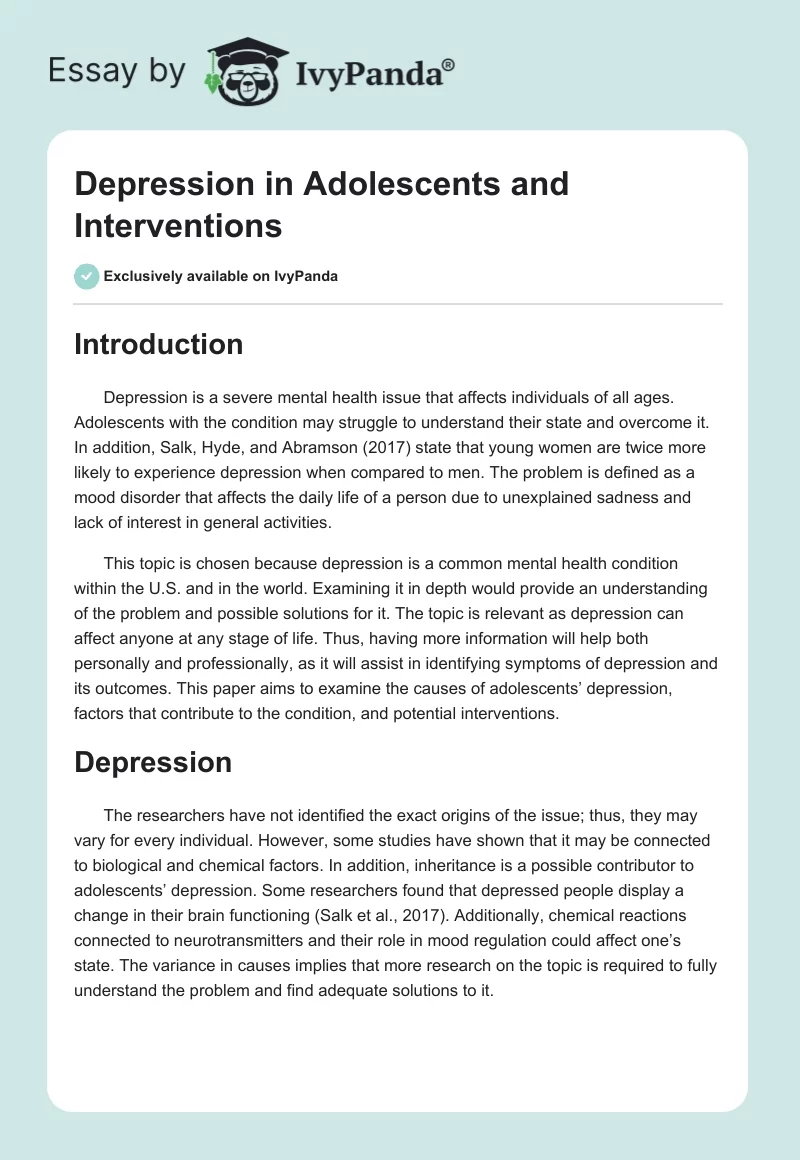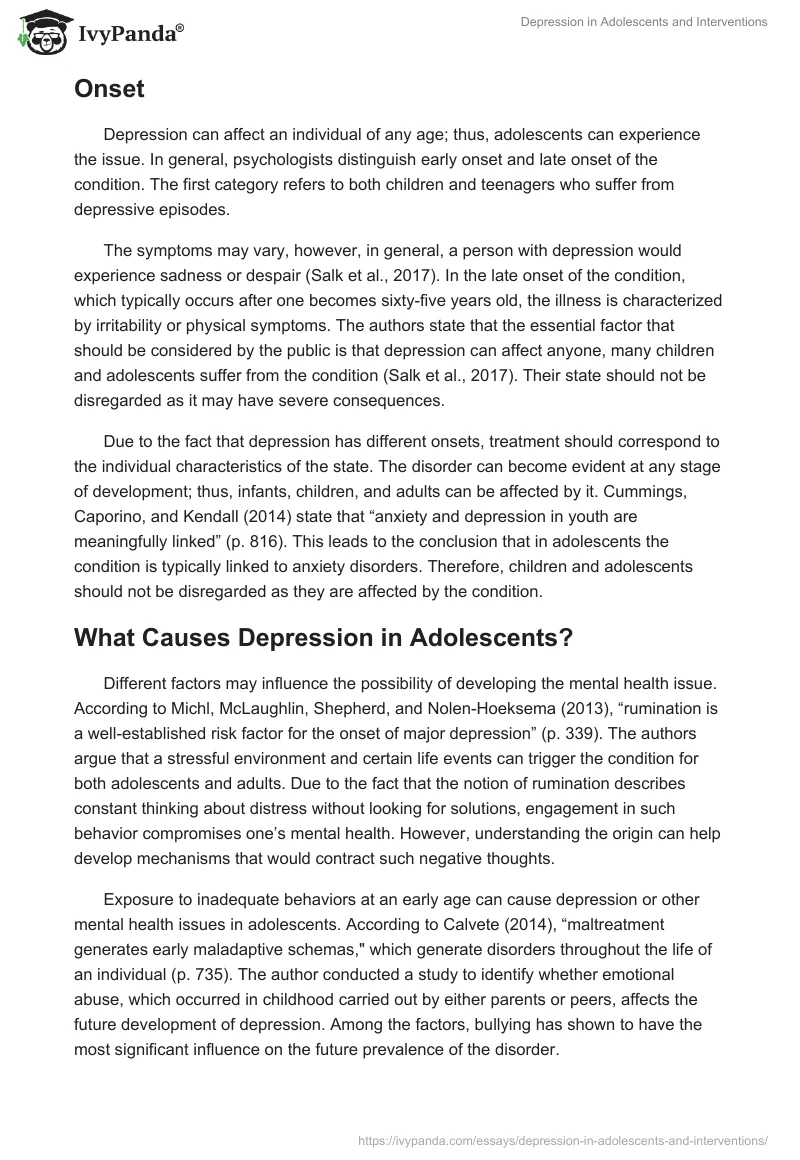Introduction
Depression is a severe mental health issue that affects individuals of all ages. Adolescents with the condition may struggle to understand their state and overcome it. In addition, Salk, Hyde, and Abramson (2017) state that young women are twice more likely to experience depression when compared to men. The problem is defined as a mood disorder that affects the daily life of a person due to unexplained sadness and lack of interest in general activities.
This topic is chosen because depression is a common mental health condition within the U.S. and in the world. Examining it in depth would provide an understanding of the problem and possible solutions for it. The topic is relevant as depression can affect anyone at any stage of life. Thus, having more information will help both personally and professionally, as it will assist in identifying symptoms of depression and its outcomes. This paper aims to examine the causes of adolescents’ depression, factors that contribute to the condition, and potential interventions.
Depression
The researchers have not identified the exact origins of the issue; thus, they may vary for every individual. However, some studies have shown that it may be connected to biological and chemical factors. In addition, inheritance is a possible contributor to adolescents’ depression. Some researchers found that depressed people display a change in their brain functioning (Salk et al., 2017). Additionally, chemical reactions connected to neurotransmitters and their role in mood regulation could affect one’s state. The variance in causes implies that more research on the topic is required to fully understand the problem and find adequate solutions to it.
Onset
Depression can affect an individual of any age; thus, adolescents can experience the issue. In general, psychologists distinguish early onset and late onset of the condition. The first category refers to both children and teenagers who suffer from depressive episodes.
The symptoms may vary, however, in general, a person with depression would experience sadness or despair (Salk et al., 2017). In the late onset of the condition, which typically occurs after one becomes sixty-five years old, the illness is characterized by irritability or physical symptoms. The authors state that the essential factor that should be considered by the public is that depression can affect anyone, many children and adolescents suffer from the condition (Salk et al., 2017). Their state should not be disregarded as it may have severe consequences.
Due to the fact that depression has different onsets, treatment should correspond to the individual characteristics of the state. The disorder can become evident at any stage of development; thus, infants, children, and adults can be affected by it. Cummings, Caporino, and Kendall (2014) state that “anxiety and depression in youth are meaningfully linked” (p. 816). This leads to the conclusion that in adolescents the condition is typically linked to anxiety disorders. Therefore, children and adolescents should not be disregarded as they are affected by the condition.
What Causes Depression in Adolescents?
Different factors may influence the possibility of developing the mental health issue. According to Michl, McLaughlin, Shepherd, and Nolen-Hoeksema (2013), “rumination is a well-established risk factor for the onset of major depression” (p. 339). The authors argue that a stressful environment and certain life events can trigger the condition for both adolescents and adults. Due to the fact that the notion of rumination describes constant thinking about distress without looking for solutions, engagement in such behavior compromises one’s mental health. However, understanding the origin can help develop mechanisms that would contract such negative thoughts.
Exposure to inadequate behaviors at an early age can cause depression or other mental health issues in adolescents. According to Calvete (2014), “maltreatment generates early maladaptive schemas,” which generate disorders throughout the life of an individual (p. 735). The author conducted a study to identify whether emotional abuse, which occurred in childhood carried out by either parents or peers, affects the future development of depression. Among the factors, bullying has shown to have the most significant influence on the future prevalence of the disorder.
Issues with brain development can be a cause of depressive disorder in adolescents. According to Whittle et al. (2014) “volumetric change in the hippocampus, amygdala, and putamen from early to mid-adolescence was associated with the onset of depression during adolescence” (2014). Thus, a neurologic risk factor exists which can predisposition an individual to developing the condition. The study, however, does not clarify the causes of such changes; further research is required to identify the problem and find possible solutions.
An interesting aspect of depression causes is connected to modern technology’s effect on adolescents. Some researchers argue that the use of the internet affects young people as it offers an unrealistic display of other people’s lives and can change the thinking process. However, Jelenchick, Eickhoff, and Moreno (2013) conducted a study to evaluate the prevalence of depression in adolescents that use social media platforms for at least two hours each day. The authors state that no connection between the mental health problem and social media was found. Therefore, no implication that internet or Facebook, in particular, impairs one’s mental state is in place.
Treatment and Intervention
Several approaches are considered to be helpful in treating depression in adolescents. Primary, cognitive behavioral therapy (CBT) and pharmacotherapy can be applied as treatment options. Michl et al. (2013) emphasize the importance of preventing depression episodes by identifying the factors that contribute to a person’s rumination. Additionally, this can help with further intervention as it allows minimizing the adverse effects of such components. Thus, a mental health professional should choose a proper treatment plan depending on the causes and severity of the condition.
Other options can be applied to treating depression as well. According to Arjadi, Nauta, and Bockting (2018), internet therapy can be implemented as an alternative approach. It can be utilized as either substitution or a complementary method to the regular treatments. However, the level of depression should be the primary indicator of whether such intervention would have positive effects or not. It can be concluded that an ideal intervention would consist of an assessment of the causes and severity of the issue. These factors should influence the treatment plan, as several options exist.
Parental Involvement
As was previously mentioned, the exposure to stress at an early age can be a contributing factor to developing depression. Parents have an essential role in an infant’s life; thus their attribution to both evolvement of depression and its treatment should be considered. According to Park, Fuhrer, and Quesnel-Vallée (2013), the education level of a mother affects the likelihood of a mental health problem for an adolescent. Therefore, parents have a crucial role in helping their children coop with such events. The general environment that a child grows up in has an impact on his or her mental health.
Additionally, no significant connection between the education levels of a father was found to affect the mental health of a child. Park et al. (2013) state that “mothers tend to play a larger role in childrearing, it may be that their parenting skills, or the social learning that takes place in terms of teaching coping skills” (p. 1836). Other factors, such as socioeconomic status of the parents or substance abuse can potentially affect one’s mental health.
Prevalence
Depression among adolescents in the U.S. has strikingly high levels of prevalence. According to Park et al. (2013), around 18% of males and 28% of females suffer from depression before they reach the age of eighteen. Considering the statistics, it is evident that women are in a high-risk group for mental health issues. In addition, the Center for Disease Control and Prevention (n.d.) states that the number of children who had a depressive episode within a two-week period from 2009 until 2012 is estimated at 7.6%. Furthermore, around ten percent of therapist visits are connected to the mental health condition in question. Thus, depression is a problem that many of the adolescents in the U.S. have to deal with in their daily lives.
Conclusion
Overall, depression among adolescents in the U.S. is a serious issue as many people are affected by it. It may be difficult to identify a single intervention plan that would be suitable for everyone; however, CBT, pharmacotherapy, or internet therapeutic sessions can be helpful. Among the factors that contribute to this mental health, problem development are the environment in which the child is raised, trauma, bullying, and biological aspects. The element that I was not aware of before this research is that females are more likely to have depression when compared to males. Another interesting fact is that maternal education level influences the likelihood of a child having mental health disorder in the future.
References
Arjadi, R., Nauta, M. H., Bockting, L.H. (2018). Acceptability of internet-based interventions for depression in Indonesia. Web.
Center for Disease Control and Prevention. (n.d.) Depression. Web.
Cummings, C. M., Caporino, N. E., & Kendall, P. C. (2014). Comorbidity of anxiety and depression in children and adolescents: 20 years after. Psychological Bulletin, 140(3), 816–845. Web.
Jelenchick, L. A., Eickhoff, J. C., Moreno, M. A. (2013). “Facebook depression?” social networking site use and depression in older adolescents. The Journal of Adolescents Health, 52(1), 128-130. Web.
Michl, L. C., McLaughlin, K. A., Shepherd, K., & Nolen-Hoeksema, S. (2013). Rumination as a mechanism linking stressful life events to symptoms of depression and anxiety: Longitudinal evidence in early adolescents and adults. Journal of Abnormal Psychology, 122(2), 339–352. Web.
Park, A. L., Fuhrer, R., Quesnel-Vallée, A. (2013). Parents’ education and the risk of major depression in early adulthood. Social Psychiatry and Psychiatric Epidemiology, 48(11), 1829-1839. Web.
Salk, R. H., Hyde, J. S., & Abramson, L. Y. (2017). Gender differences in depression in representative national samples: Meta-analyses of diagnoses and symptoms. Psychological Bulletin, 143(8), 783-822. Web.
Whittle, S., Lichter, R., Dennison, M., Vijayakumar, N., Schwartz, O., Byrne, M. L. … Allen, N. B. (2014). Structural brain development and depression onset during adolescence: A prospective longitudinal study. The American Journal of Psychiatry, 171(5), 564-671. Web.


